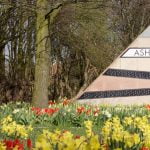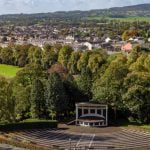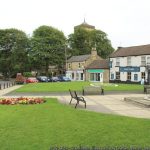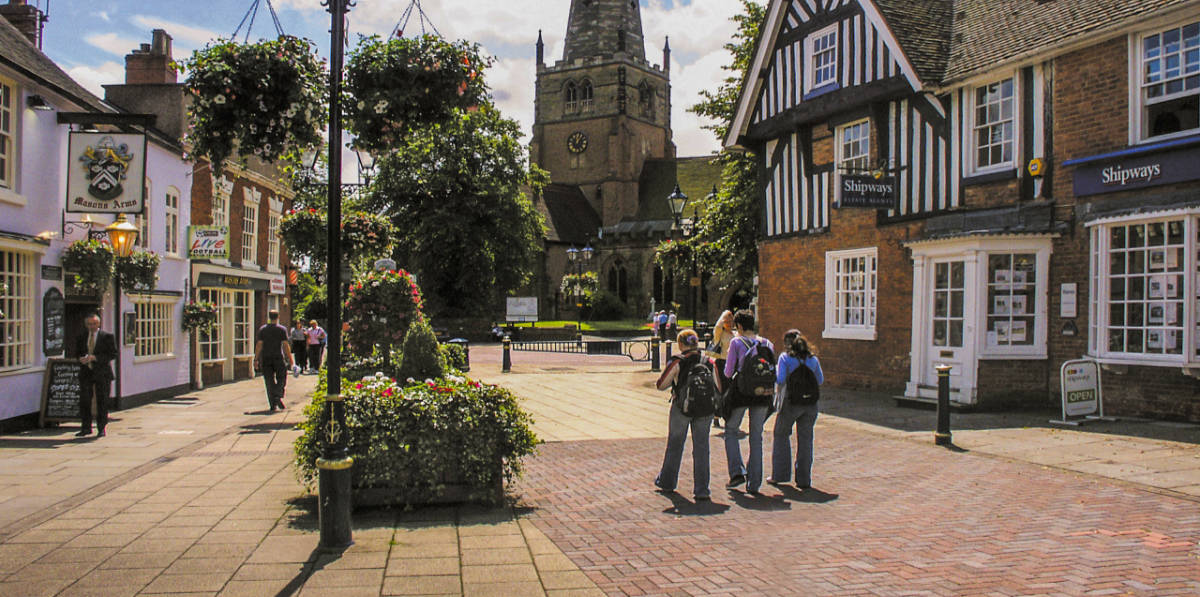
Solihull The Rather Quaint West Midlands Town On The River Blythe.
Somewhere in the Forest of Arden, you will find Solihull, still not far enough away from Birmingham to escape being industrialised, but on the edge. This quaint little former market town was the apple in the eye of the English crown, although that apple might have been sauced and stored for one too many winters.
Anyway joking aside we wanted to get to know all about this somewhat overlooked yet historic place, in an effort to spread some staycation love. We believe old England is a glorious place to take your holidays in, and we are determined to help you find the right spots to visit.
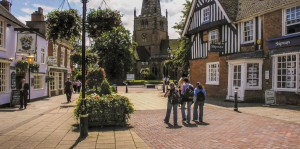
Image: David Hughes/Shutterstock.com
With that in mind, let’s hop aboard for the five-minute whirl around Solihull. What is it, where is it, and what has it got going for it? We found out so you could have something to read while you’re on your break. Ok, let’s start with a little of the history, well it’s as good a place as any to start!
The Early Days of Solihull
The area we now know as Solihull was once covered by the ancient forest of the area. During the Iron Age, a settlement was built on the site of the hill, where the people could raise the earthen embankments and make a protective hill fort to live in. Even when all people had been sheep and grain there were those that refused to grow their own and tried to steal from others.
The hillfort was still there circa 1 BC and would have been about 10 acres across from one point to the other. Situated in the middle of the woods as it was, it would have acted as a deterrent to potential raiders.
It is not thought that the Romans came near here. It is believed that the forest was so dense back in those days, that it was left well alone. There were Romans in the Fort to the northwest and in Alcester to the south. However, as far as we know the Romans didn’t settle the forest.
If we cut forward a hundred years or so after the Romans left in the early AD’s, we would see that the population of this considerably small hill fort town had grown. The land was farmed between the people that lived there. It would have been a close-knit community since bringing things in from the outside wasn’t really possible. The original name of the settlement was ‘Ulverlei’, which translates to the clearing belonging to Wulfhere.
The town belonged to the Earls of Mercia up until the days when England united into one place. The land belonged to the family of Lady Godiva, who rode into the market on horseback naked to protest her point. The Arden Family that owned the manor for generations bought over the manor in the 12th century, but before that, it belonged to the descendants of the Lady herself.
Although not recorded in the Domesday Survey (perhaps due to the density of the woodland), the town was recorded as being owned by a descendant of King Ethelred the Unready in 1086. After this it was passed to one of the Normans… a family named de Limsey.
The family decided they would grow a village out of the manor and set about planning it out. This is the first official beginnings of the town.
Medieval Solihull
The old town area thence became known as Ulverlie Olton, while the new town became known as Solihull. The de Limsey family set up free tenure known as burgage tenure, allowing settlers to come to the town. They built a castle on the land, which lies in ruin now at a local area known as Hobs Moat. The castle was last occupied in the 14th century and is unlikely ever to be so again.
The St Alphege church went up in the 13th century and still stands to this day. It is now a Grade I listed building. The spire is 168 feet high and would have been a suitably impressive feat for the day. The same century saw the manor established and an annual fair held on the 18th-20th April. Slowly, the town would turn into a market town situated on the River Blythe.
At the end of the 13th century, the manor passed hands again to the de Birmingham family, then later to the Le Despencer family. Warring families in the area saw Hugh Despenser executed and the family shamed. They would later become favourites again, but for a few years, the manor would have fallen into disrepair. The Manor was called Longdon and within it Simon de Malverne was assassinated in 1317. The manor house was handed to the crown in the 1400s after the Despensers were decided to be traitors.
The 14th century saw the town become famous for blacksmiths so that Smythestreet was named for their abundance. Unfortunately, much of the forest was burned for fuel for the smithies. Cloth was also made here, first from wool, later from silk and cotton. There was a holy spring in town on the site of St Alphege church too, which would have brought many tourists during this time.
Interestingly, Shakespeare’s family is named in the local church registers in Balsall. His son Hamnet was baptised in the area in 1560.
The manor continued to change hands at the king’s behest over the coming centuries. Notably, it was owned by the Throckmorton family, yes the ones behind the Gunpowder Treason Plot of 1605. They and the other three families involved were all put to death. A grizzly rumour has it that one of the plotters died on the rack in the torture chambers of the Tower of London, but that his lifeless body was executed anyway, to prove a point.
2 more manor houses were added to the area over the years. 1495 say the Greswolde family inherit Longdon, then they built a new house closer to town. A reverend also had a manor built nearby. Hillfield Hall was built in 1576 by a family of lawyers and several farms were built. Solihull school was built in 1560 and the George Hotel was built in this century.
During the English Civil War in the 1600s, Solihull didn’t appear to take sides. There was a skirmish nearby named the Battle of Kings Norton, but it had little to do with Solihull. The manor switched hands yet again and would remain the property of the Greville family going into the start of the Industrial Era.
Let’s take a break there and have a spot of fun. History is interesting but too much and you get a headache for your trouble.
Solihull Trivia
We dug up the best fun facts and trivia that we could find regarding this sunny town on the River Blythe. Whether you are there on holiday or whether you just want to impress your friends, here are our favourite fun facts:
- We already mentioned that Shakespeare’s family were from here, but we figured it was such an impressive claim to fame that we could stand to mention it twice.
- A USwitch survey once named this place one of the best places to live in the UK and, frankly, they haven’t shut up about it since.
- There is as much greenery around here as there is town. Birmingham Live points out that three-quarters of the borough is designated a green belt area.
- Jaguar and Land Rover have their bases here.
- Solihull has joined in the town twinning craze, but more modestly than many. Their twins are Cholet in France & Main-Taunus-Kreis (more of a region) in Germany.
- Ideal Home suggests you could live longer by moving here, based on the average life expectancy being greater than that of the national average. Must be all that green space!
With those lovely little snippets of trivia under our belts, let’s get back to the history. There are only a few hundred years left to get through before we are all caught up.
The Industrial Era of Solihull
Malvern Hall was started in the 18th century but wouldn’t be finished until 1809. The builders, the Greswoldes, converted the estate into the Malvern Park and the hall became part of the school. The Holbeche family built their own hall in 1712 which is now demolished but that the shopping centre is named for.
In 1815, Longdon manor passed into the hands of Lord Byron. After his death, the manor changed hands several more times. Monkspath Priory was built in the 1870s and in 1898 a cheese manufacturer moved to the area. The framed pen maker Joseph Gillot built a hall in the area in the 1890s.
All these buildings both added opulence to the area and maintained the greenery. While the rest of the country was becoming industrialised, Solihull remained the place where the industry owners retired to at the end of the week for a break. As a result, it managed to stay undamaged throughout the 19th century when most towns became heavily overcrowded and dirty.
The first telephone that was installed outside London was placed in Castle Bromwich, not then part of Solihull but it is now. The end of the 19th century saw both the telephone and postal service reach the town, but the train would have arrived in the 1840s.
20th Century Solihull
In 1909, a woman named Cathleen Cartland founded one of the first non-denominational schools in the country. Later, the schools of the area would gain more attention when JRR Tolkien’s son taught in them.
In the First World War, the nearby village of Hockley Heath was bombed by a lost Zeppelin. Shadow Factories were built in two requisitioned farms in the area. After the war, the Land Rover company bought the factories – but the purpose of them was top secret.
Solihull’s part in the Second World War wasn’t just restricted to shadow factories. In fact, they received plenty of children from the nearby cities and kept them safe until the war was over. The prime minister came here to open the airport in 1939 only to requisition it for use in the war. In 1960 it was given to Birmingham Airport and it was renamed to the airport you know and love today.
Post War
In 1954, the queen granted a Royal Charter to incorporate Solihull into a County Borough. All the small towns and villages surrounding the area became part of the town – which still managed to retain its massive Green Belt areas.
In the 60s the high street was improved with a shopping centre, parks were added, and churches, homes and shops were built. Since then. A tornado in nearby Shirley in the 80s has been one of few notable activities in the area.
The modern Solihull is known for attractive architecture from the early 19th century. It is filled with listed buildings perched neatly between a leafy forest. It is a town set in the countryside, which feels like it’s a rural town even though it has more than 100,000 residents.
That seems like a nice stopping point for the history so that we can cover the other aspects of Solihull.
Famous People from Solihull
We can’t move on to the attractions of the area before we review the most famous people who have come from this area. Here are the Five Minutes Spare favourite famous faces to have come from Solihull:
- Poet’s William Shenstone and Richard Jago were from here and had parts of the school dedicated to them.
- Another Poet, W H Auden, was born and grew up here.
- BBC reporter Michael Buerk lives in Solihull.
- Alan Cox, the man who is responsible for Linux, is a Solihull man.
You can find a few more famous faces from Solihull with a quick search. We just wanted to do a quick summary before we get to the good stuff… what there is to do in Solihull if you are spending a city break there.
Top Attractions of Solihull
If you are spending a few days or even a few hours in Solihull, here are some of the best things to see and do there.
Historic Sights and Landmarks
The biggest landmark in town is still the Church. St Alphege Parish Church is one of the tallest spires in town. It’s a 13th-century church with Grade I listed status and some awesome architecture for you to check out. If you are interested in churches, the Elmdon Parish Church is another striking building that holds weekly services.
Head out into the forest and see the Hobs Moat ancient monument. These are the ruins of the old castle which fell out of use in the 14th century. Have a good explore but be wary of metal detecting in protected areas like this one. There’s not much of the castle left to see but the nature trail to get there is lovely. The site is run by Historic England.
Galleries and Museums
The Core Theatre in Solihull is one of the main attractions of the town. It doubles as an art gallery and event space, as well as being a live show theatre. It’s one of the top-rated attractions in Solihull and even comes with its own bar. If theatres reopen again, this is one to watch.
You should head to the Creation Art Gallery if you want to look at some local works. They will be able to set you up with some Solihull artists or even with a blank canvas of your own.
There aren’t many museums in the area, but you can head to Blakesley Hall Museum to enjoy one of the old manor buildings in style. You could also visit the National Motorcycle Museum if you are in town and see a stunning display of vehicular beauty. One way or another, there is a museum that will entertain you in Solihull.
Outdoor Attractions
The Malvern and Brueton Park is a top attraction in the area. It was the same park built by local nobility in the 1800s and is still favoured today by locals. There’s a nice picnic area and there is even a nature reserve included. There’s plenty of greenery around because this is Solihull… but this is an acceptable place to sunbathe in the summertime.
Elmdon Park is a similar place to enjoy an afternoon, walk your dog, or trace the trail by the lake. It’s a lovely area which has its own church and nature reserve. It’s a Green Flag awarded area with plenty of wildlife for the kids to spot. There is a football pitch, some tennis courts, and free parking.
Head to the Umberslade Farm Park to give the kids a great day out. This place has a petting zoo and its own adventure playground. There are nature trails to follow, picnic areas and a café to eat out at, and even a tractor ride and small animal feeding at the right times of year.
One last mention for the Heronfield Small Breeds Farm and Animal Rescue Centre. Pay them a visit and give whatever you can. They do great work. The kids love the animals and the feeling of being able to help. It’s something we should all try not to lose as we age.
Don’t forget that Solihull has plenty of countryside for you to enjoy.
Shopping and Retail
You can get the best shopping in the Solihull town centre, where there are plenty of grocery type markets. If you want clothing or gifts, head to the Mell Square shopping centre, instead.
There are a fair amount of garden centres and artisan shops in the area that you can enjoy.
Although not quite a shopping centre, we weren’t sure where else we could put this one. There is a National Conference Centre in Solihull that holds intermittent events throughout the year.
Sports and Recreation
The Local football team is Solihull Moors who currently (2021) compete in the National League (tier 5). This is quite an achievement for a team which was only formed in 2007! Catch them at Damson Park, which is around two miles away from the town centre. The stadium has a 5,500 capacity and given their record attendance so far is 3,681 you should be able to pay at the gate. Mind you if they were to draw either Birmingham City or Aston Villa in the cup that would change. They have been pretty good in that competition of late so who knows.
Since Solihull is a reasonably affluent area, they are in possession of the full three golf club’s customary to well-off English towns. You can choose from the Widney Manor Golf Club, the Robin Hood Golf Club, or the Olton Golf Club.
In terms of recreation, one of the best things to do in town with teens is to take them to Planet Ice. This is a good, old fashioned ice rink. Teens can go along on a Saturday night and enjoy a skating disco, or you can book it for events. The kids can’t get enough.
Other Notable Solihull Attractions
There are too many great things about this town to go into them all in detail. However, we have tried to cover as many as we can. Those we missed above are mentioned here as further things you should see and do if you remain in town.
- The Tudor Grange Park is another nice park option. There are plenty of them in leafy Solihull.
- Take the kids to the Haystacks Play Barn for some fun playground time.
- Babbs Mill Lake is a great place to go to feed the birds.
- Any number of nature walks. The Dorridge Park and Dorridge Woods, The Millisons Wood Local Nature Reserve, and the Hillfield Park to name but a few.
- Any number of churches, including St. John the Baptist’s, the Parish Church of Saint Mary Magdalene Tanworth-in-Arden, and the Knowle Parish Church.
There really are loads of things to see and do in Solihull. All you need is a little determination to find them and the free time to enjoy them.
How to Get There
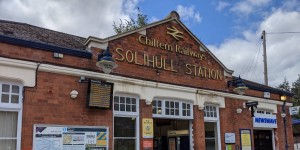
Image J M Ritchie/Shutterstock.com
We wouldn’t be good tour guides if we didn’t at least try and give you directions.
By Road
Follow the A41 south and east out of Birmingham.
By Rail
Look for Solihull Train Station on the West Midlands line.
By Air
Birmingham Airport is pretty much on top of Solihull.
By Boat
You are landlocked but there is a river and a canal for those of you who are feeling ingenious.
Still, Got 5?
If you still have break time left to spare, head on back to our main pages. We have travel articles aplenty for you to sink your travelling teeth into. It might be the year of the staycation but that doesn’t mean there aren’t some excellent locations for you to holiday in.
